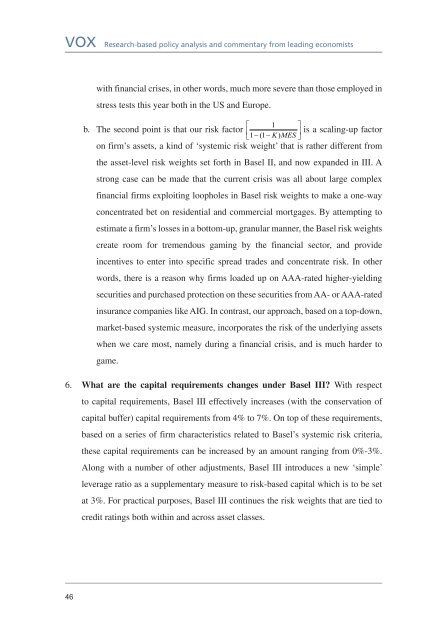Create successful ePaper yourself
Turn your PDF publications into a flip-book with our unique Google optimized e-Paper software.
VOX Research-based policy analysis and commentary from leading economists<br />
46<br />
with financial crises, in other words, much more severe than those employed in<br />
stress tests this year both in the US and Europe.<br />
⎡ 1 ⎤<br />
b. The second point is that our risk factor ⎢<br />
1 − (1 − K) MES<br />
⎥ is a scaling-up factor<br />
⎣ ⎦<br />
on firm’s assets, a kind of ‘systemic risk weight’ that is rather different from<br />
the asset-level risk weights set forth in Basel II, and now expanded in III. A<br />
strong case can be made that the current crisis was all about large complex<br />
financial firms exploiting loopholes in Basel risk weights to make a one-way<br />
concentrated bet on residential and commercial mortgages. By attempting to<br />
estimate a firm’s losses in a bottom-up, granular manner, the Basel risk weights<br />
create room for tremendous gaming <strong>by</strong> the financial sector, and provide<br />
incentives to enter into specific spread trades and concentrate risk. In other<br />
words, there is a reason why firms loaded up on AAA-rated higher-yielding<br />
securities and purchased protection on these securities from AA- or AAA-rated<br />
insurance companies like AIG. In contrast, our approach, based on a top-down,<br />
market-based systemic measure, incorporates the risk of the underlying assets<br />
when we care most, namely during a financial crisis, and is much harder to<br />
game.<br />
6. What are the capital requirements changes under Basel III? With respect<br />
to capital requirements, Basel III effectively increases (with the conservation of<br />
capital buffer) capital requirements from 4% to 7%. On top of these requirements,<br />
based on a series of firm characteristics related to Basel’s systemic risk criteria,<br />
these capital requirements can be increased <strong>by</strong> an amount ranging from 0%-3%.<br />
Along with a number of other adjustments, Basel III introduces a new ‘simple’<br />
leverage ratio as a supplementary measure to risk-based capital which is to be set<br />
at 3%. For practical purposes, Basel III continues the risk weights that are tied to<br />
credit ratings both within and across asset classes.














